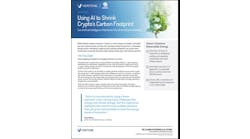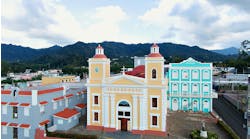Battered by Hurricane Michael last year, the City of Tallahassee and researchers are trying to design a storm-hardened microgrid system, one that considers both engineering and human psychology.
The city is working with a cross-disciplinary research team from Colorado State University (CSU) that won a $194,000 grant in June from the National Science Foundation. The team hopes to create a microgrid that would minimize damages and losses even in Category 5 hurricanes.
Hurricane Michael brought down 90% of Tallahassee’s electricity grid and cut the interconnection to a neighboring utility that ultimately affected 1.2 million people in the Southeast. Aiming to avoid damages of that scope, the research team is working with city officials and departments to review emergency preparedness plans and existing utilities and infrastructure.
Hurricane Michael’s destruction in Tallahassee. Photo by KMH Photovideo/Shutterstock.com
Their goal is to create a design framework for Tallahassee that can be used by other communities, according to Sid Suryanarayanan, CSU Dept. of Electrical and Computer Engineering professor and project leader.
“We are confident that there is a significant place for microgrids in providing resilience to electricity grids in hurricane-prone regions. What we intend to bring to the table is the use of behavioral psychology and systems engineering concepts of emergency response in the design and operation of these microgrids,” he told Microgrid Knowledge.
Achieving stakeholder buy-in
The CSU research team is applying their collective expertise in electrical power engineering, microgrid design and operation, behavioral psychology, and emergency response to identify and reconcile design trade-offs, Suryanarayanan explained.
A sustainable grid needs to balance costs on three legs: environmental, budgetary viability, and costs passed on to customers, he said.
The team will gather information and analyze the attitudes and behavior of Tallahassee businesses and consumers when it comes to energy. That aspect of the project is being carried out by Pat Aloise-Young, CSU associate professor of psychology, who has worked on behavioral energy efficiency programs.
“The team’s convergence of expertise is predicated on our past successes and the recognized, yet often overlooked, need for engaging sociologists and experts from emergency response teams in the design phases,” Suryanarayanan said in an interview. “The ability to render our engineering solutions useful to a wider range of users and personnel is the highly valuable product of this convergence.”
“…you can design all the technology you want, but it’s not going to achieve the benefits you hoped for if you don’t have stakeholder buy-in.”
Aloise-Young will lead a data gathering effort that will include utility customer interviews and surveys with the goal of providing a broad-based social context to the technical work led by Suryanarayanan. Understanding what utility customers need — and what they’re willing to trade off — is key to the microgrid design plan.
“I think engineers are coming to realize that you can design all the technology you want, but it’s not going to achieve the benefits you hoped for if you don’t have stakeholder buy-in,” Aloise-Young said.
Surveys will be carried out in two phases. The first one entails gathering responses from utility personnel. The second may feature focus groups of community participants. With that done, the researchers intend to prioritize and model alternatives using computer simulations, then analyze them before presenting them to the focus groups.
Join the Microgrid Knowledge LinkedIn Groups:
Microgrid Knowledge, Distributed Energy Resources and Community Microgrids.
Why microgrids
“This project was a result of a recognition of the need to build resilient, self-reliant, and local sources of electric power supply that can help in maximizing the resources available in the interconnected electric grid, especially during and after calamitous events like hurricanes Maria in 2017 and Michael in 2018,” Suryanarayanan said. “When hurricane Michael left 1.2 million Americans without electricity in October 2018, we convened a team to tackle the problem by proposing a research idea to the National Science Foundation Rapid Response Program.”
The researchers anticipate that microgrids will be an integral facet of the grid resiliency and emergency response design they ultimately come up with. There are three key reasons for that, Suryanarayanan explained:
- Microgrids hold the promise for providing electricity supply during catastrophic events, as was the case with the Sendai microgrid during the Fukushima Daiichi nuclear meltdown event in 2011.
- Microgrids are increasingly accepted as utility-approved components of a distribution grid.
- Costs are falling of environment-friendly generation assets.
CSU’s research work complements the city’s own initiatives.
“Earlier this year Tallahassee developed a community resilience plan and adopted a clean energy resolution with the goal of moving our community to 100% renewable energy by 2050,” said Michael Ohlsen of the City of Tallahasse Utilities Electric System Integrated Planning group. “We’re in the process of hiring a consultant to assist with an energy integrated resource plan (IRP) and community-wide clean energy plan.”
Track news about microgrid research. Subscribe to the free Microgrid Knowledge newsletter.







